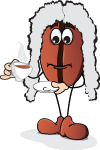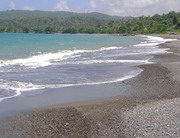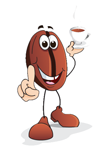|
Hello again, Your coffee: real or phoney: quality or rubbish??
Just thought this would get you in relaxed, "tropical paradise" mode!! One of the many, deserted beaches, along the north coast, lapped by the warm Caribbean sea, but without the best of the sandy beaches. In an earlier episode, I promised to give you some information on how to spot phoney coffee: our Coffee Industry Board, who check ALL Jamaican coffee for quality, before allowing it to be exported, have a list of specifications for all the different grades of coffee, that Jamaica produces; and rigorously enforce these standards: but they have limited control over the coffee, once it leaves Jamaica. Whilst I can only comment on our JBM coffee, the principles/guidelines outlined below, should apply to most good and great, coffees. The main factors in the quality of the coffee: the beans themselves (where and how they are grown); the processing (especially the drying, sorting and grading of the dried beans); the storage, and roasting of the beans. Probably the most important factor is the "honesty and integrity" of the seller/retailer: the sales "pitch", and the packet labelling, all being a totally honest and truthful, description, of the contents of the packet. As always, it is a case of "Buyer Beware". If you have found some real JBM coffee; it will be as near perfect as is possible, with none of the defects I have mentioned below: just a single noticeable defect in the coffee, and the Coffee Board would NOT have given it the export license. You have to make due allowances for problems which are outside the control of the vendors: for example, a badly sealed or faulty packet, or transit damage: any reputable vendor should offer an immediate replacement, for any such "damaged" coffee. If you see some JBM for sale, and the price appears "reasonable": check out the details on www.ciboj.org ; if they have no displayed, info on the particular seller or brand, e-mail them, and they will advise you. Request that the seller tells you exactly where the coffee came from, who supplied it: and then check the name given against the list of "Licensed Coffee Dealers", at the CIB website. Only licensed coffee dealers can export (via the Coffee Board) any coffee from Jamaica, Before anyone can import Jamaican coffee, they are checked-out by the Coffee Board, and have to be licensed; again, check the Coffee Boards' web site, to see if the seller is licensed. There is a list of all the "approved" coffee importers, throughout the World, on the web site. Some of the licensed importers will sell some of the coffee "through the trade", so, again inquire of the seller, to find the original importer, and check against the list. If they are, in any way, "reluctant or unwilling" to give you the information: they are almost certainly, NOT selling real JBM. Check carefully and totally avoid any coffee that has the word "blend" on it: the blend could be as low as a single JBM bean in a whole pound of other coffee! Jamaican "High Mountain" coffee, is the same coffee as the real JBM, grown above 2,000 feet, but in areas outside the designated Blue Mountain, national park: and lacks a little of the "fullness" of a JBM, still it is an excellent coffee, well worth a try, if you can find any. Your "highest odds" of getting real JBM, is to buy green beans, the "odds" are greatly reduced if you buy roasted coffee. Unless you are very lucky, or get the coffee from a really reputable supplier, approved by the coffee board, to buy roasted, ground JBM, is almost a guarantee, of wasting your money, and getting some rubbish, instead.The Coffee Board, can, using their batch numbers, and export records, trace the majority of the JBM that is exported, from the processor, here in Jamaica, to the retailer; almost anywhere in the world. One quite obvious check, is the price; No 1 grade, green bean, JBM, is currently US$13 per pound, at Kingston port: allowing for shipping costs, roasting costs, and everybody along the chain, making money: if it looks too cheap, it is not JBM coffee! Google earth: of MY plantation: The GPS pointer is right in the middle of the car park, just above the house, which is the white roofed structure, just to the left of the "+" spot. The road visible towards the top of the picture, is my drive, which runs along the apex of the ridge, not easy to see in the picture, but the land slopes steeply down, from both sides of the drive. The picture (a composite: with most of it dated 2005) appears, from the shadows, to have been taken, late afternoon, towards the end of the year. To be continued... Robin Plough, friend of www.coffee4dummies.com For questions about JBM, mail to: Этот e-mail адрес защищен от спам-ботов, для его просмотра у Вас должен быть включен Javascript |
Assessing your coffee (part 1)
Assessing your coffee (part 1)








